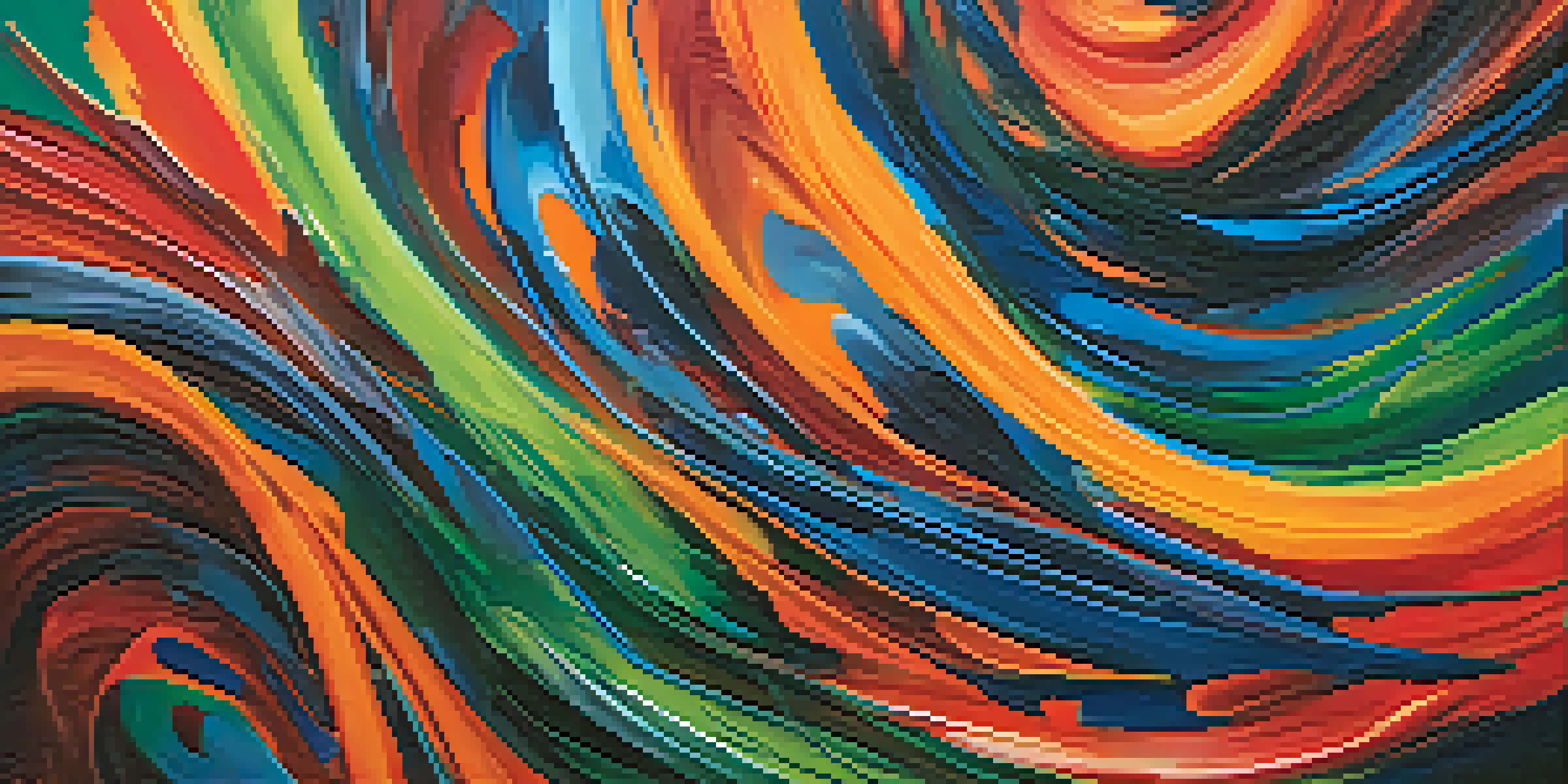Narrative Structures in Abstract Art: A New Perspective

Understanding Abstract Art and Its Unique Language
Abstract art often feels like a puzzle, where the pieces are emotions and ideas rather than recognizable forms. Unlike traditional art, where you can easily identify subjects, abstract pieces invite viewers to interpret meaning based on their personal experiences. This fluidity in interpretation opens up a world where each observer can create their own narrative, making the artwork deeply personal.
Art is not what you see, but what you make others see.
Consider a painting splashed with vibrant colors and chaotic brush strokes. To one person, it might evoke feelings of joy and freedom, while another might see confusion or chaos. This subjective experience is at the heart of abstract art, challenging us to engage with it beyond surface aesthetics and dive into our internal dialogues.
By framing abstract art as a narrative journey, we encourage deeper connections between the artwork and the viewer. This perspective allows for a richer appreciation of the complexity and emotional weight carried by seemingly simple shapes and colors.
The Role of Composition in Telling a Story
Composition in abstract art serves as the backbone of its narrative structure, guiding the viewer’s eye and emotions. Think of it as the plot of a story; how elements are arranged can suggest conflict, resolution, or even a climax. For example, a central figure may draw your attention, suggesting importance or urgency, while surrounding elements can either support or contrast that focus.

Just like in literature, where the arrangement of words can alter the meaning, the placement of colors, shapes, and lines in a painting can dramatically change its perceived narrative. A chaotic arrangement might communicate turmoil, while a balanced one could suggest harmony or peace. This interplay creates a dynamic experience, where each viewer's interpretation can shift with their perspective.
Abstract Art Invites Personal Narratives
Each viewer interprets abstract art through their own experiences, creating unique and personal stories.
Thus, the composition becomes a silent storyteller, communicating themes and emotions that may not be immediately obvious. Understanding this can enhance our appreciation of abstract art, revealing layers of meaning that contribute to our overall experience.
Color as a Narrative Device in Abstract Art
Color is perhaps the most powerful tool in an abstract artist’s arsenal, evoking emotions and setting the tone for the narrative. For instance, warm colors like reds and oranges often suggest energy and passion, while cool tones like blues and greens can evoke calmness or sadness. This emotional palette invites viewers to engage with the piece on an emotional level, crafting their own stories based on their feelings.
The painter tries to master color; the poet tries to master words; the musician tries to master sound. But the master of art is the one who can make you feel.
Imagine walking into a gallery filled with abstract works. One painting bursts with fiery reds, instantly energizing the space, while another, draped in soft blues, wraps you in tranquility. These contrasting colors not only affect your mood but also guide you towards different interpretations of each piece, creating a unique narrative experience.
By understanding how color influences our perception, we can unlock deeper meanings within abstract art. The artist's choice of hue isn't random; it’s a deliberate move to evoke specific feelings and reactions, enriching the viewer's connection to the work.
Symbolism in Abstract Art: A Hidden Narrative
While abstract art may seem free from traditional symbols, many artists embed subtle references that contribute to its narrative. These symbols can be personal, cultural, or universal, offering layers of meaning that enhance the viewer's experience. For example, a recurring circle might symbolize unity or eternity, prompting viewers to reflect on their own interpretations.
This hidden narrative invites exploration and curiosity, as viewers unravel the layers of symbolism woven into the artwork. Just like reading between the lines of a novel, discovering these symbols can lead to a richer understanding of the piece’s emotional core. The more we delve into these meanings, the more we appreciate the artist's intent and the story they wish to convey.
Composition Guides Emotional Responses
The arrangement of elements in abstract art acts like a plot, influencing how viewers perceive its narrative and emotional depth.
By recognizing and interpreting these symbols, we become active participants in the narrative, transforming our experience from passive observation to engaged storytelling. This dynamic interaction can deepen our emotional connection to abstract art.
Personal Experience: The Heart of Abstract Narratives
Each viewer brings their own experiences and emotions to an abstract artwork, creating a unique narrative that reflects their individual journey. This personal lens can significantly alter how one interprets the piece, making the art a mirror of one's life and feelings. For instance, someone who recently experienced loss might see a painting of dark hues as a representation of their grief.
This connection between personal experience and abstract art highlights the importance of subjective interpretation in weaving narratives. Just as a reader may relate to a character's struggles in a novel, viewers often find resonance in abstract forms that speak to their own lives, creating a bridge between the artist’s intention and the observer’s reality.
By embracing our personal stories, we enrich the narrative of abstract art, allowing it to evolve and resonate in ways that are meaningful to us. This shared experience creates a vibrant tapestry of interpretations, where no two stories are alike.
The Impact of Cultural Contexts on Interpretation
Cultural backgrounds play a significant role in shaping how we interpret abstract art, influencing our narratives in profound ways. What might seem chaotic to one culture could represent freedom or self-expression to another. This diversity in interpretation enriches the dialogue surrounding abstract art, allowing for multiple narratives to coexist.
For example, an abstract piece inspired by indigenous patterns may evoke feelings of heritage and connection for some, while others might not recognize its cultural significance. This underscores the importance of understanding the cultural context of an artwork, as it can unveil layers of meaning that might otherwise go unnoticed.
Color Shapes Emotional Interpretation
Colors in abstract art evoke specific emotions, guiding viewers to engage with the artwork on a deeper emotional level.
By acknowledging these cultural influences, we can foster a deeper appreciation for the narratives present in abstract art. It encourages us to approach each piece with an open mind, ready to explore the myriad stories that shape our collective understanding.
Conclusion: Embracing Narrative Structures in Abstract Art
Understanding narrative structures in abstract art invites us to engage more deeply with the pieces we encounter. Rather than seeing abstract art as mere decoration, we can appreciate it as a rich narrative landscape, filled with emotions, symbols, and personal stories. This perspective not only enhances our viewing experience but also encourages a more profound dialogue between artist and observer.
As we explore the layers of composition, color, symbolism, and personal experience, we uncover the unique narratives that each piece offers. This journey transforms our interactions with abstract artwork, allowing us to connect on emotional and intellectual levels, creating a shared experience that transcends individual interpretations.

In embracing these narrative structures, we honor the complexity of abstract art and the diverse stories it can tell. So, the next time you stand before an abstract piece, take a moment to reflect on the narrative it presents and the personal story it sparks within you.